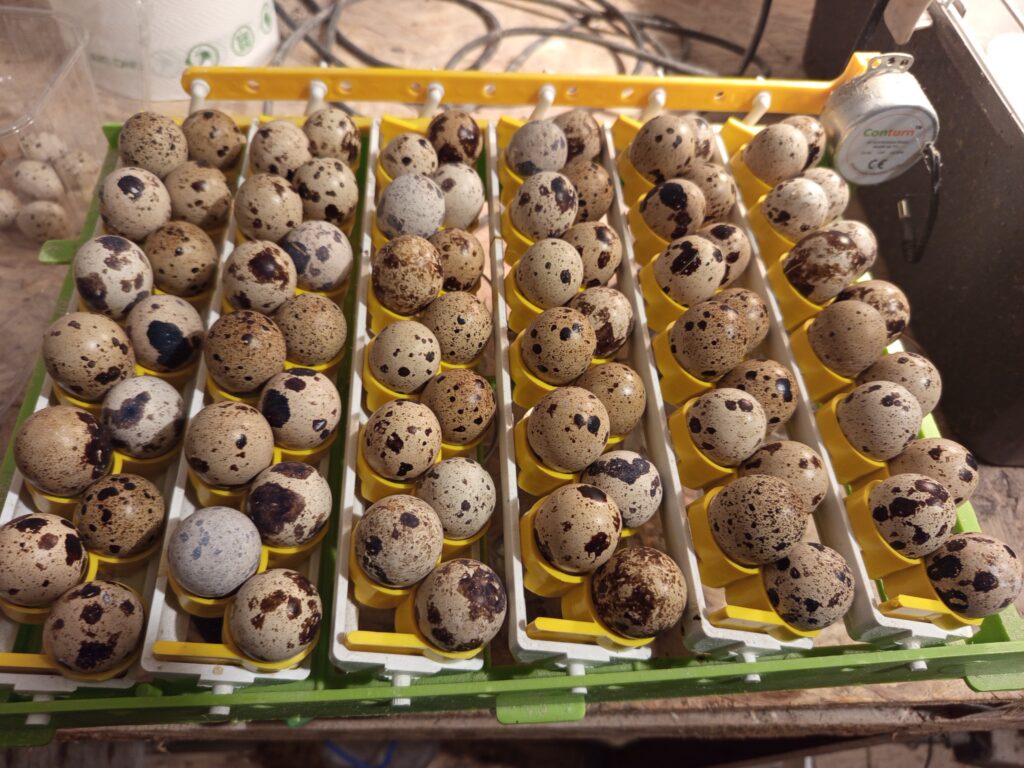The incubator is humming with new life again. 78 fresh quail eggs have just begun their 17-day journey, and there’s a renewed sense of optimism in the air. After our previous batch’s challenges with constant power outages, we’re eager to see what these eggs can achieve under more stable conditions.
A Fresh Start
Sometimes farming is about bouncing back. The 52% hatch rate from our storm-interrupted batch taught us valuable lessons about backup power systems and weather preparedness, but it also left us hungry to prove that our breeding stock and incubation techniques are sound.
These 78 eggs represent more than just another batch—they’re our chance to test our quail program under optimal conditions and see what kind of results we can achieve when Mother Nature cooperates.

Better Conditions This Time
No storms in the forecast for the next 17 days, which already has us feeling more confident. The incubator is running smoothly, power supply is stable, and we’ve made some improvements to our backup systems after the lessons learned from the previous hatch.
The eggs themselves look excellent—consistent size, good shell quality, and sourced from our best-performing breeding pairs. We’ve been selective about which birds contribute to this batch, choosing our most reliable producers with the best fertility rates.
Refined Techniques
Experience with the previous batch has led to some subtle refinements in our approach:
Temperature monitoring is now even more precise, with additional backup thermometers to ensure we catch any fluctuations immediately.
Humidity management has been fine-tuned based on what we observed worked best during the successful portions of the last hatch.
Egg handling procedures have been streamlined to minimize stress on the developing embryos during turning and candling.
Realistic Optimism
With stable power and improved techniques, we’re cautiously optimistic about achieving significantly better results than the 52% hatch rate from our storm-challenged batch. Under ideal conditions, quail can achieve 70-80%+ hatch rates, and we’re hoping to get into that range.
Our goal: 60+ healthy chicks from these 78 eggs. That would represent a substantial improvement and validate that our breeding program and incubation skills are progressing in the right direction.
What Success Looks Like
A successful hatch from this batch would mean several things for our operation:
Breeding program validation: Confirmation that our parent stock selection and breeding decisions are producing viable, hatchable eggs.
Technique confidence: Proof that our incubation methods work well under normal conditions, and that the previous challenges were truly weather-related rather than systematic issues.
Production capacity: 60+ new quail would significantly expand our flock, providing more breeding options and production capacity for the future.
The 17-Day Timeline
Days 1-5: Critical early development phase, maintaining perfect temperature and humidity consistency.
Day 7: First candling to assess fertility and early development—hopefully showing much higher fertility rates than we could properly assess during the storm-interrupted batch.
Days 8-14: Rapid development phase, with careful monitoring of all environmental conditions.
Day 14: Second candling to evaluate development progress and remove any non-viable eggs.
Days 15-17: Lockdown period with increased humidity and the anticipation of what we hope will be a much more successful hatch.
Learning from Setbacks
The previous batch’s challenges reminded us that farming is as much about resilience as it is about technique. Every setback provides information, and every new attempt is a chance to apply those lessons.
These 78 eggs represent our commitment to continuous improvement and our confidence that the fundamentals of our operation are sound, even when external circumstances create challenges.
Looking Forward
Seventeen days from now, we’ll know whether our optimism was justified. We’re hoping for a hatch that not only recovers from the previous disappointment but establishes a new standard for our quail breeding program.
The incubator is maintaining perfect conditions, the power is stable, and the countdown has begun. Sometimes the best response to a challenging hatch is simply to load up the incubator again and get back to work.
Here’s to 78 eggs, stable weather, and the kind of hatch results that make all the careful monitoring and preparation worthwhile.
How do you handle setbacks in your farming or breeding programs? Share your experiences with bouncing back from disappointing results—we’d love to hear how others maintain optimism and keep improving!
What’s your strategy for learning from less-than-perfect hatches? Tell us about your approach to continuous improvement in breeding programs!